Tweeks: Black Canary Vs Scarlet Witch
This week we battle it out to see whose favorite super heroine is the best. Maddy brings her favorite DC Superhero Black Canary to the fight against Anya’s favorite Marvel Superhero Scarlet Witch.
This week we battle it out to see whose favorite super heroine is the best. Maddy brings her favorite DC Superhero Black Canary to the fight against Anya’s favorite Marvel Superhero Scarlet Witch.
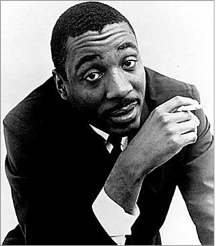 Now as I was young and fuzzy, mired in what we were assured was a university education, just beginning to pull my head out of my… Okay, look – no need for vulgarity here. Let’s leave it at this: I was pulling my head from the sand and becoming aware of kinds of culture other than what I was being fed to us by radio and movies (that Bob Hope! What a stitch!) and that alien entity in the living room we called “the teevee” or “the television” or simply “the set.”
Now as I was young and fuzzy, mired in what we were assured was a university education, just beginning to pull my head out of my… Okay, look – no need for vulgarity here. Let’s leave it at this: I was pulling my head from the sand and becoming aware of kinds of culture other than what I was being fed to us by radio and movies (that Bob Hope! What a stitch!) and that alien entity in the living room we called “the teevee” or “the television” or simply “the set.”
(No need for further elaboration: we had only two sets, the one in the living room and the one Mom kept tucked away somewhere and that we saw only on the most festive of occasions, such as Christmas and the like, Oh, and full disclosure; I’m not sure we ever really had a holiday meal on the family set. Mostly we did our holidaying at relatives’ places.)
Did I mention that Bob Hope was also on the (living room) set where, I guess, he continued stitching? Or that I was once in a one-act play with his daughter Linda, but never spoke to her? (Could that be why I didn’t get a Christmas card from the Hopes?)
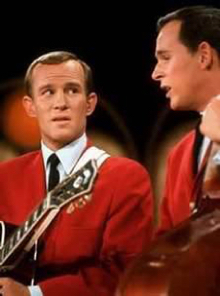 But this isn’t about Bob and his show-biz peers – Bing Crosby, Eddie Cantor, Edgar Bergen, Jimmy Durante, those guys, oldish performers many of whom began in vaudeville. No, this is about the newish laugh-makers: Woody Allen, Mike Nichols and Elaine May, the Smothers Brothers, Lenny Bruce, Mort Sahl… closer to Mark Twain than Bozo the Clown. And Dick Gregory. Especially Dick Gregory. (Mother-in-law jokes not welcome.) Their humor was well-observed, hip, topical, and sometimes about pain. You wouldn’t catch their acts on the broadcast networks, but you could enjoy them, sometimes, at live shows of various kinds.
But this isn’t about Bob and his show-biz peers – Bing Crosby, Eddie Cantor, Edgar Bergen, Jimmy Durante, those guys, oldish performers many of whom began in vaudeville. No, this is about the newish laugh-makers: Woody Allen, Mike Nichols and Elaine May, the Smothers Brothers, Lenny Bruce, Mort Sahl… closer to Mark Twain than Bozo the Clown. And Dick Gregory. Especially Dick Gregory. (Mother-in-law jokes not welcome.) Their humor was well-observed, hip, topical, and sometimes about pain. You wouldn’t catch their acts on the broadcast networks, but you could enjoy them, sometimes, at live shows of various kinds.
Then the world’s change accelerated, humor along with everything else, and humor and news intermingled and, lo and behold, on Sunday nights we can now see the newest kind of new comedian, the comedian-activist. The program is called Last Week Tonight and it stars a Brit named John Oliver. Oliver delivers a brief news item – about 10 minutes long – and then a longer piece, loaded with irreverence and disrespect and gags and facts. You may not always get facts from the non-comedic news venues (though some seem to be cozy with “alternate facts.”) But Oliver always delivers the real deal.
This week, he upped his game. After presenting a detailed story concerning certain politicians’ ongoing efforts to revoke the legal protections laws that guarantee internet neutrality, he suggested that we pro-neutrality fight back by communicating with our senators. Then he told us how. Use that internet to contact your senator by visiting this address: www.gofccyoursef.com. The screen will tell you how to proceed from there.
Marifran did it. I did it. Your turn.
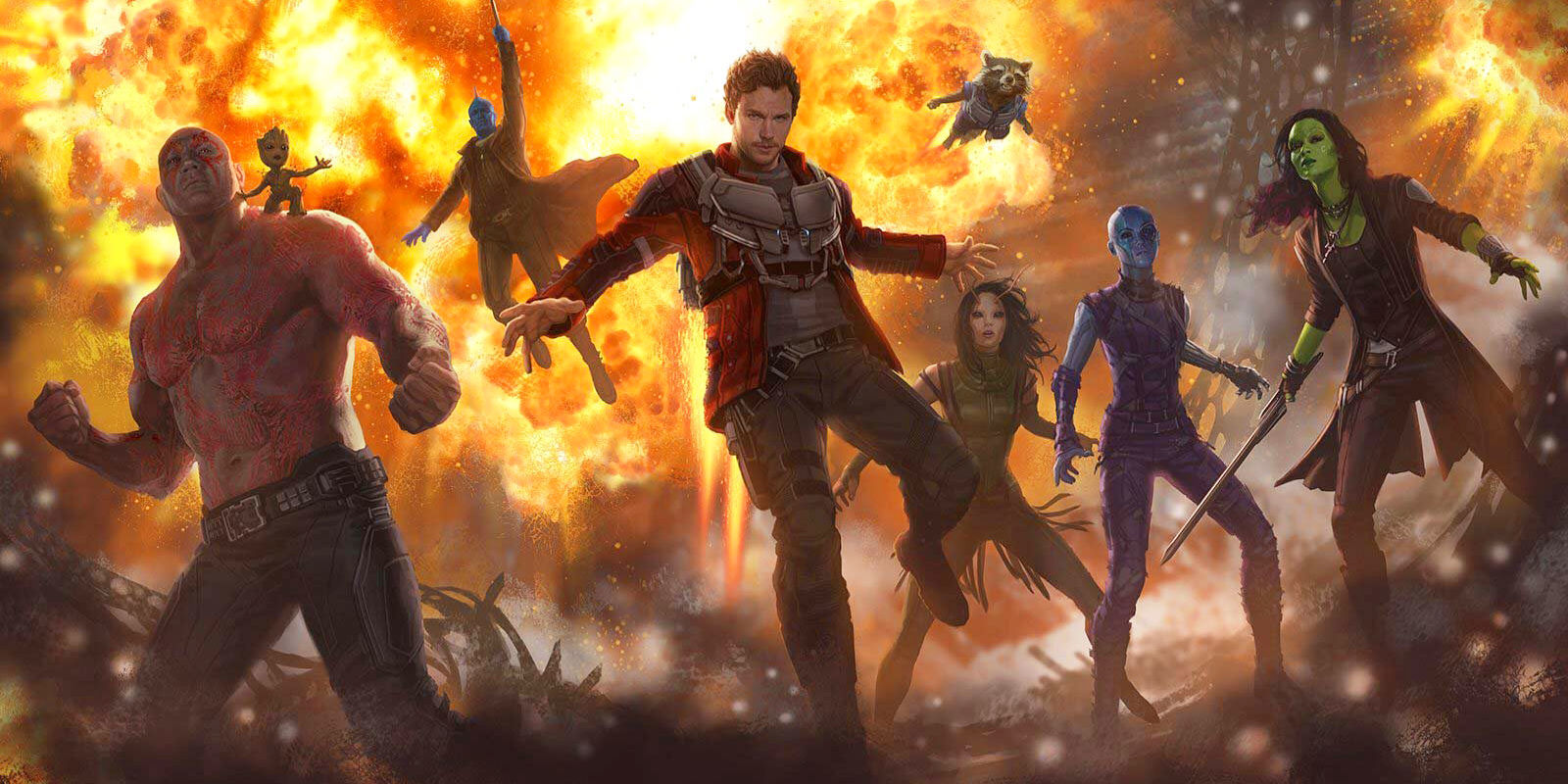
Guardians of the Galaxy Vol. 2 is an amazingly charming movie. The characters they’ve constructed over these two movies are each a delight. There’s an infectious camaraderie that makes it feel like it must be the best movie set to work on the there ever was. The infectious joy and prodigious joke density easily carries a slightly disjointed script through the murky bits. I don’t need everything to make sense or even be particularly important as long as I’m having fun and the rest of the theater is having fun. There aren’t many movies more infectiously fun than Guardians of the Galaxy Vol. 2.
There are two separate stories being told in Guardians of the Galaxy Vol. 2. In one Star-Lord meets his father, Ego the Living Planet (Kurt Russell), and goes to his home planet (or his self? There’s nothing in the MLA rules about this) along with Gamora and Drax. Why do Gamora and Drax come with him? It would appear to balance the crew between the two stories because both of them barely interact with this story from the time they land on the planet until the third act. In the other story, Rocket Racoon and Groot are captured by Ravagers and are going to be turned in for some sort of bounty involving stolen batteries. This storyline is mostly about making baby Groot jokes and having people mistake Rocket for another kind of rodent. It eventually hooks back up with the rest of the crew— not because it needs to, but more because they’re done. These plots are not grand adventures in storytelling but rather a frame for character moments and jokes and they’re just fine for that, but I think they deserve to be called out for being a bit sparse.
The Guardians are such wonderfully distinct characters though. Drax’s laugh is the glue that holds the first half of the movie together. It isn’t what I thought would happen to the Drax character on the big screen, but he’s basically all comedy at this point with little action in sight. Bradley Cooper is never going to get any recognition for this, but he’s doing fabulous work as Rocket. He imbues a lot of humanity in to a character it would be so easy to not take seriously. Rocket has a tearjerker of a line near the end that could easily fall flat. The best scene in the whole film is between Gamora and Nebula talking about their familial relationship. I never thought it would be believable to transition Nebula to the side of the Guardians after all the bad blood in the last movie and they accomplish it in three lines. It’s the best scene between two women in any Marvel movie and I understand I’m not setting a particularly high bar. It’s high now.
James Gunn has made a great looking movie. There are so many shots with so much going on and they’re especially fun to take in in 3D. There’s this concerted effort to have stuff going on in the background of shots and it’s a great way to sneak stuff in. It looks an awful lot like a 1970s cosmic comic book. I wouldn’t say Kirby-esque, I think we’re too liberal with Kirby-esque, it doesn’t look like Jack Kirby drew it but it looks an awful lot like Walter Simonson and that’s no slight. The sequence that caps off the Rocket Racoon plot is the best of the whole film, it’s a great bit of elaborate camera work and fun violence. The climax of the main plot is a little less impressive if only because there are a lot of supposed to be dramatic moments of people facing down grey goo. Grey goo is not that scary.
Go see Guardians of the Galaxy Vol. 2. It’s a great time. Get a big popcorn and a smaller drink (it’s a very long movie) and just enjoy being in an air conditioned room with other people having a good time. My wife remarked that the emphasis on family and reforming some former adversaries makes this Guardians feel like a step toward transitioning to a sort of Fast & Furious in space thing. I agree, and there’s nothing I would rather see from Marvel than something that leans so in to that kind of joy and absurdity. I hope they can do it.

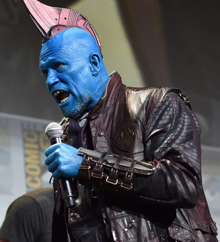 If you think working in the greater comic book conspiracy is all fun and games – well… there’s a lot of truth to that. For example, where else can you go to the movies, call it work and then take the ticket price off your taxes?
If you think working in the greater comic book conspiracy is all fun and games – well… there’s a lot of truth to that. For example, where else can you go to the movies, call it work and then take the ticket price off your taxes?
Last Thursday, I joined fellow ComicMixers Adriane Nash and Joe Corallo in the wildlands of Milford Connecticut (where the phrase “Milf” was coined) for the debut of Guardians of the Galaxy Volume Two. We went for the full movie monty: IMAX 3-D at a ticket price that would cause Uncle Scrooge to quit working for Disney. When I plop my ass down in a movie theater seat, I am hoping I’m not wasting my time and all that energy I spent looking for a parking place. In the case of next month’s Wonder Woman, I will plop my ass down in a movie theater seat praying I’m not wasting my time… but I digress.
I had no such concerns for GOTG2. All the cast, crew and management had to do is jack up the action slightly and change the soundtrack and write some new gags. If Looney Tunes could do it for nearly four decades, James Gunn could do it twice. If, after seeing the movie, you find yourself debating whether it was as good as the first, not as good as the first, or better than the first – you’re thinking too hard. To paraphrase Joel Hodgson and Josh Weinstein, “It’s just a show, you should really just relax.” If you’re going to go to a movie like this with a stick up your ass, you’ll never get past the vicious furball who runs around carrying ordinance bigger than he is, let alone the pithy-yet-cute jumping twig that steals every scene he’s in.
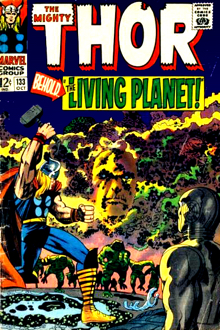
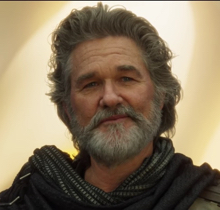 In other words, we had a great time watching a very funny movie with an exceptionally high body count. If that sort of thing bothers you, don’t take your kids. Anyway, they’ll have more fun seeing it behind your back.
In other words, we had a great time watching a very funny movie with an exceptionally high body count. If that sort of thing bothers you, don’t take your kids. Anyway, they’ll have more fun seeing it behind your back.
GOTG2 even made fun of the mighty Marvel movie method. There are five inter-credits scenes (they should start running the closing credits at the beginning of GOTG3) and more cameos than you can count. While it is impossible to translate a comic book property to the big screen without making some changes, GOTG2 came remarkably close to the source materials while maintaining the continuity from the first movie as well as the other Marvel Studios flicks. In fact, they even managed to do a quick tribute to Jack Kirby’s original depiction of Ego The Living Planet – they didn’t have to, but it was a nice touch for those of us who remember.
Remarkably, this movie fits squarely into the current Marvel Studios trans-flick story arc, and does a lot to set up next year’s Avengers: Infinity War. You are probably aware that the GOTG leads are all in that one, but then again, so is everybody else. I wouldn’t be surprised to see Ben Afflick in there somewhere.
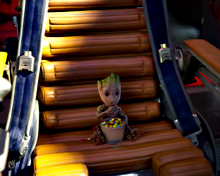
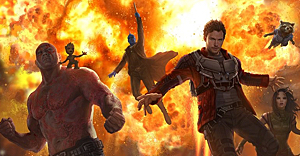 And speaking of Ben Afflick, if that nightmare of a movie Batman v Superman degenerated into a story about heroes with severe mommy issues, then Guardians of the Galaxy Volume Two is about a hero with severe daddy issues. But unlike the aforementioned DC movie, Guardians makes it work without insulting the audience. Kurt Russell turns in a wonderful performance as god.
And speaking of Ben Afflick, if that nightmare of a movie Batman v Superman degenerated into a story about heroes with severe mommy issues, then Guardians of the Galaxy Volume Two is about a hero with severe daddy issues. But unlike the aforementioned DC movie, Guardians makes it work without insulting the audience. Kurt Russell turns in a wonderful performance as god.
The soundtrack, built around the theory that obnoxious tunes from the 1970s sound much better forty years later, is different from the first film, as one might expect. What I did not expect is for them to include a tune I play about once a year on Weird Sounds Inside The Gold Mind: Lake Shore Drive, by Aliotta Haynes Jeremiah. It’s really a beautiful song about the remarkably calming major highway that separates the City of Chicago from the parkland that hugs the coast of Lake Michigan. Quite frankly, I would think Rocket “Raccoon” would hate it.
We had a swell time. What more could you want for the money? If you were expecting Citizen Kane Volume Two, you need to change your meds.
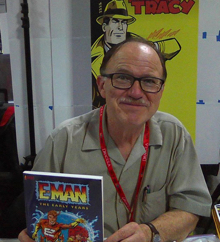 Drew Ford has spent the last few years of his life dedicated to bringing classic out of circulation comics and graphic novels back in print in beautiful restored editions. A fierce advocate for creators such as Sam Glanzman, Drew has brought back multiple books of his work, a graphic novel from David Michelinie, another graphic novel from ComicMix’s own Denny O’Neil, and many more. This was originally done through Dover Publications until Drew founded It’s Alive! Press, an imprint of IDW.
Drew Ford has spent the last few years of his life dedicated to bringing classic out of circulation comics and graphic novels back in print in beautiful restored editions. A fierce advocate for creators such as Sam Glanzman, Drew has brought back multiple books of his work, a graphic novel from David Michelinie, another graphic novel from ComicMix’s own Denny O’Neil, and many more. This was originally done through Dover Publications until Drew founded It’s Alive! Press, an imprint of IDW.
Drew’s latest project is bringing Family Man, by Jerome Charyn and Joe Staton, back in print through a Kickstarter campaign. You can view the campaign here.
I got the chance to interview Joe Staton this past weekend about Family Man.
JC: Thank you so much for taking the time to talk to me about today about Family Man! Before we get into that, you’re a comics veteran with over forty years of work under your belt. You’ve worked on comics like E-Man which you co-created, All-Star Comics, a long run on Green Lantern where you created the Omega Men with Marv Wolfman, and have more recently worked on the classic character Dick Tracy. Which of all your comics work is most meaningful to you and why?
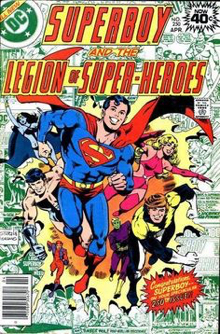 JS: And thank you for the interest in our project. You’re right, I’ve been at this for a while. I suppose if I come down to what’s the most important to me it would be E-Man, the Helena Wayne Huntress, my runs on GL with Marv and Steve Englehart, and my current work on the Dick Tracy strip. I had the chance to develop characters sort of off on a tangent from what was expected. E-Man was somewhere on the border of funny and serious, Helena was the product of Earth II, where everything was an alternate take on DC history, my work on GL got me into visualizing SF aliens, always some of my favorite stuff. Tracy, I’ve always wanted to do. With Mike Curtis we’re trying to plug into classic Chester Gould while seeing Tracy as part of pop culture from the 20s up through now.
JS: And thank you for the interest in our project. You’re right, I’ve been at this for a while. I suppose if I come down to what’s the most important to me it would be E-Man, the Helena Wayne Huntress, my runs on GL with Marv and Steve Englehart, and my current work on the Dick Tracy strip. I had the chance to develop characters sort of off on a tangent from what was expected. E-Man was somewhere on the border of funny and serious, Helena was the product of Earth II, where everything was an alternate take on DC history, my work on GL got me into visualizing SF aliens, always some of my favorite stuff. Tracy, I’ve always wanted to do. With Mike Curtis we’re trying to plug into classic Chester Gould while seeing Tracy as part of pop culture from the 20s up through now.
JC: Since I’m a big Legion of Super-Heroes fan and have read a lot of your work on it, I was wondering if you could humor me and talk a little bit about your time on that title.
JS: Paul Levitz brought me into the Legion without me knowing a lot about them. I was supposed to be part of a rotation with three or four other guys but for one reason or another, they dropped off and I wound up doing the most of a run. I was never able to get a handle on the characters as super-heroes so I got into the science fiction elements. It’s just lately that I’ve realized that the heart of the series is “teen romance in space.”
JC: Okay, now onto Family Man! What’s your elevator pitch for Family Man?
JS: One hour into the future, society and government in New York City are crumbling. The only forces that still maintain order are the Mob and the Church. Alonzo, a gangster, and his brother Charles, the monsignor, face each other for control.
JC: So how did you end up collaborating with Jerome Charyn, a very accomplished writer in his own right, but not so much in comics?
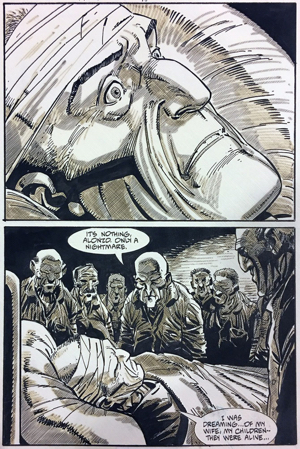 JS: Editor Andy Helfer was putting together a line of nontraditional crime books mixing regular comics types and people from outside. He knew that was something that I would be up for. I was originally scheduled to work on a book with Pete Hamill but Pete never got his script in and Andy suggested that I might work with Jerome. I had read Jerome’s work and thought that was a good idea. I’ve recently learned that Jerome had originally wanted to be a comics artist. But rather than go that way, he’s written around 50 novels and nonfiction. His earlier interest in art made it natural for him to describe visuals to tell a comics story.
JS: Editor Andy Helfer was putting together a line of nontraditional crime books mixing regular comics types and people from outside. He knew that was something that I would be up for. I was originally scheduled to work on a book with Pete Hamill but Pete never got his script in and Andy suggested that I might work with Jerome. I had read Jerome’s work and thought that was a good idea. I’ve recently learned that Jerome had originally wanted to be a comics artist. But rather than go that way, he’s written around 50 novels and nonfiction. His earlier interest in art made it natural for him to describe visuals to tell a comics story.
JC: The vast majority of your published comics work at this point in your career was in superhero comics. What did you have to do differently to tackle a story like this? What was the same?
JS: Much of my work was in super-heroes, but partially that was just a function of what was being published. There was work in super-heroes. And even then, as I mentioned earlier, I’ve often wound up working on stories that are a bit outside the usual take on heroes. And I do have a history with crime and detectives. E-Man’s sidekick is Michael Mauser, the unsanitary PI. I worked on the Mike Danger comic strip with Max Collins. Chris Mills and I have our series Femme Noir, which was originally a tribute to The Spirit. My basic interests are SF and crime stories, rather than so much super-heroes. Turned out Family Man was a good fit.
JC: Much of your prior comics career was in monthly comics. Family Man was originally done as three 96-page digest comics. How did you approach working in this format? What were the challenges and benefits of it?
JS: I was drawn to comic strips when I was a little kid, especially Dick Tracy and The Phantom. I learned to think in terms of comic strips before I came to comic books. Jerome had quite conveniently written Family Man as four-panel and it would be in a square format. Four panel, square, lay them out in a row, and you have a comic strip. There is occasionally a two-panel page, rarely a single panel splash, but the comic strip concept still fit. For me, it wasn’t a question of monthly as opposed to a limited format, it was going from comic book pages to comic strip. Since Family Man wasn’t going for super-hero exaggerated foreshortening or pyrotechnics, it was comfortable in the squares.
JC: What about Family Man makes it an important story to you?
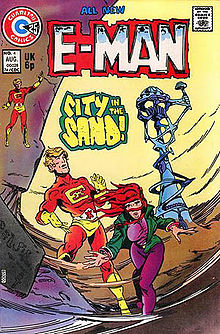 JS: In terms of what a “graphic novel” actually means, we need to remember that Jerome is an accomplished novelist. A novel usually implies layered storylines and characters and that’s what Jerome has provided here.
JS: In terms of what a “graphic novel” actually means, we need to remember that Jerome is an accomplished novelist. A novel usually implies layered storylines and characters and that’s what Jerome has provided here.
JC: It’s been twenty-two years since Family Man first came out and it has not been in print for the vast majority of that time in between. What about this story rings true today and would attract a new generation of comics readers?
JS: “One hour in the future” turned out not to be the future when the book was written but with us turning away from the structures of government and society it may be a future around the corner today.
JC: Why is It’s Alive Press the best place for Family Man and why is crowdfunding the best way to fund reprinting it?
JS: Drew Ford is repackaging solid projects that didn’t quite find their audience, maybe because they never had a proper collection or came out from smaller presses or whatever. Things like Sam Glanzman’s USS Stevens stories, Trina Robbins’ Dope. Family Man should be right at home at It’s Alive Press.
JC: Before we wrap this up, I want to thank you again for taking the time to talk with me and ask you if there is anything else you’d like to mention about the Family Man Kickstarter currently running or if you had any other work you’d like to note?
JS: As we’re speaking the Kickstarter still has a bit of a way to go, a few days left and some cash still needed. I hope everybody will head over there and contribute and get some nice premiums. As for other things, keep an eye out for an upcoming issue of Charlton Arrow, which will start to feature a new three-part E-Man from Nick Cuti and me. That should be out this summer. And I continue to draw Dick Tracy with writer Mike Curtis, available here. We just lately finished the big crossover between Dick Tracy and The Spirit. It’s all archived at GoComics.
And thanks again for the chance to plug Family Man, Joe.
As I mentioned last week, the adaptation of Margaret Atwood’s The Handmaid’s Tale is now available on Hulu. The streaming site offered the first three episodes at once, and is now releasing the rest of the 10-part series on a weekly basis every Wednesday.
I decided to binge on all four episodes when I got home from work on Friday night. Don’t do this. Really, don’t. Unless you want to be haunted by the too many and too close parallels between a fictional world and this one. Unless you want your optimism hollowed out and replaced with dread when you realize that the show is goddamn too real. From the Washington Post, February 14, 2017:
“‘I believe one of the breakdowns in our society is that we have excluded the man out of all of these types of decisions,’ he said. ‘I understand that they feel like that is their body,’ he said of women. ‘I feel like it is separate – what I call them is, is you’re a ‘host.’ And you know when you enter into a relationship you’re going to be that host and so, you know, if you pre-know that then take all precautions and don’t get pregnant,’ he explained. ‘So that’s where I’m at. I’m like, hey, your body is your body and be responsible with it. But after you’re irresponsible then don’t claim, well, I can just go and do this with another body, when you’re the host and you invited that in.’”
These are the words of Representative Justin Humphrey, a Republican freshman in the Oklahoma state legislature, who has introduced a bill which would require that a woman get the written permission of the father – who would also have to be identified in writing to the healthcare provider – before having an abortion. The individual identified as the father would also have the right to demand a paternity test.
Note the word “host” as a description of a pregnant woman. This is exactly the same word and mind-think that is used to describe the Handmaid’s function in the world of the Tale. Elizabeth Moss, who stars in the series as the Handmaid known as Offred, told Rolling Stone magazine “that hits a little too close to home.” Amen, Elizabeth.
Another bill was introduced in that same session of the Oklahoma Legislature by Representative George Faught for a second time – House Bill 1549 would force a woman to go through a pregnancy despite the fetus having, or being suspected to have, a genetic abnormality, no matter how early the woman sought an abortion. Both bills passed out of committee, but have languished in the state’s Senate.)
Among the absolutely abhorrent and despicable and disgusting and shameful things that the Republican “American Health Care Act” – what a fucking oxymoron!!! – does is defund Planned Parenthood. And then we and the rest of the world were treated to a bunch of white men celebrating and downing brewskis in the Rose Garden.
To get the putrid taste of vomit out of my mouth and to, at least temporarily, displace the dread that had (and has) overtaken my optimism, I watched the pilot of Star Trek: Voyager (“Caretaker”), which, in an odd juxtaposition, Hulu automatically started playing after I finished my binge of Handmaid’s Tale.
Was it enough to make me feel better?
For a little while.
And then the dread came back.
Geek Culture, unlike other passion businesses like sports or music, affords fans the opportunity to collaborate with fellow fans and rub elbows with professionals. I’d argue that it’s unique to this industry.
For example, music fans would find it difficult to imagine playing with Mick Jagger or Sir Paul McCartney. Oh, you might see them in concert, but to really spend time with them probably isn’t going to happen.
Likewise, even if I was a big football fan, I couldn’t realistically plan a way to spend quality time with an NFL Superstar. I did briefly meet football legends Larry Czonka and Rocky Bleier back in the 70s, but hey, that was the 70s.
But Geek Culture is different. There are so many opportunities for fans to meet their favorite creators. Like super hero movies, comic conventions are sprouting up just about everywhere.
With all these new conventions, and the inevitable competition for available weekends, I’m thrilled that our invitations to talent for Syracuse’s Salt City Comic-Con were so well received. This show has quickly developed a very impressive guest list. I anticipate it will be a fantastic opportunity for all kinds of fans to meet many of their favorite folks.
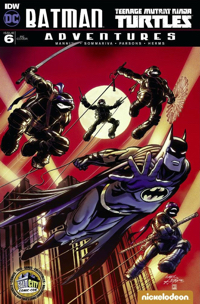 The legendary Neal Adams will be one of the creators attending. He’s a guy who’s been contributing groundbreaking art for many years. He’s also been a trailblazer – with his own entrepreneurial efforts and on behalf of creator’s rights. He seems to love conventions. He brightens up with a big smile and genuinely enjoys meeting his fans.
The legendary Neal Adams will be one of the creators attending. He’s a guy who’s been contributing groundbreaking art for many years. He’s also been a trailblazer – with his own entrepreneurial efforts and on behalf of creator’s rights. He seems to love conventions. He brightens up with a big smile and genuinely enjoys meeting his fans.
For this convention, Adams created a variant convention exclusive. The cover to this comic showcases Batman, the Teenage Mutant Ninja Turtles and (for the first time on a comic cover) Syracuse’s iconic Niagara Mohawk building.
I’m a big Batman fan from way back, so collaborating with Neal Adams, IDW, DC and the convention to create this Batman cover was really fun.
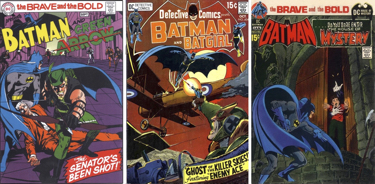 The more I thought about it, though, this was fun because it wasn’t really a Batman cover. This was going to be, essentially, a Brave and the Bold cover. B&B, as we called it back in the day, was a long-running comic series showcasing Batman with all his super hero pals. It was always an engaging read and was a strong seller for DC as well.
The more I thought about it, though, this was fun because it wasn’t really a Batman cover. This was going to be, essentially, a Brave and the Bold cover. B&B, as we called it back in the day, was a long-running comic series showcasing Batman with all his super hero pals. It was always an engaging read and was a strong seller for DC as well.
Neal Adams worked on many of the early issues of B&B, but he has always been good at team-up covers. He’s great at capturing diverse characters and making them work together.
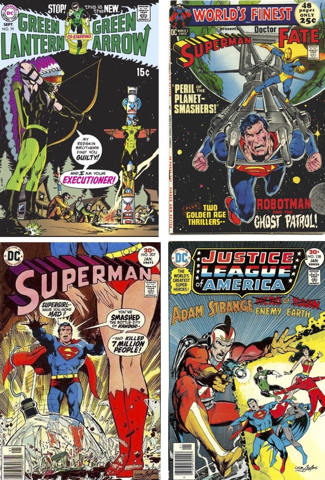 Neal Adams has also illustrated quite a few Marvel Team-Up covers to, as you can see on the top of this column.
Neal Adams has also illustrated quite a few Marvel Team-Up covers to, as you can see on the top of this column.
All this got me thinking, “What would this special Batman/TMNT cover have looked like if it was published in the 60s or the 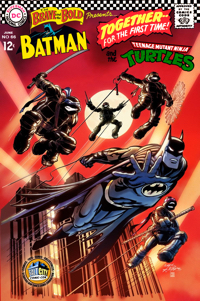 70s?” My Captain Action business partner, Joe Ahearn, brought my ideas to life with a faux Brave and the Bold 60s cover:
70s?” My Captain Action business partner, Joe Ahearn, brought my ideas to life with a faux Brave and the Bold 60s cover:
We then took it one step further and created an imaginary cover with a funky 70s vibe:As a marketing consultant, I collaborate a lot. Collaborations are fun – be it on work projects, fan projects or even comic book covers. Especially comic book covers, now that I think about it
And if you like “Imaginary” team-up covers, might I recommend the clever SuperTeamFamily: The Lost Issues site at https://braveandboldlost.blogspot.com And for more information on that Batman/TMNT variant, just check out SyracuseComicCon.com .
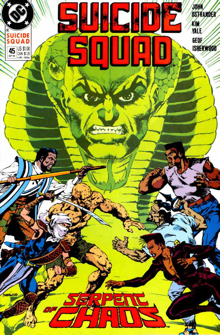 For the past few weeks we’ve been discussing the latest TPB reprint of my Suicide Squad run at DC with me giving some of my thoughts about what went into the stories. One of the things I like about this volume is that it gives a nice variety – there’s a four-part story arc, a single-issue story, another four-parter, and then a two-parter.
For the past few weeks we’ve been discussing the latest TPB reprint of my Suicide Squad run at DC with me giving some of my thoughts about what went into the stories. One of the things I like about this volume is that it gives a nice variety – there’s a four-part story arc, a single-issue story, another four-parter, and then a two-parter.
This week we’re going to focus in on the second four-parter, The Jerusalem Serpent. The villain of the piece is named Kobra, a Jack Kirby creation. He’s the leader of a cult-like terrorist group and had bounced around the DCU for a number of years. He was a made-to order bad guy for the Squad although I monkeyed with him a bit. In DC cosmology you had the Lords of Order and the Lords of Chaos (which, in itself, was patterned after the cosmology in much of Michael Moorcock’s Eternal Champion series). Doctor Fate, for example, was an avatar of the Lords of Order. So I made Kobra a follower of the Lords of Chaos, working to usher in the Kali Yuga- the Age of Chaos. The guy had a real Jones for it.
He was offset in the story by another character that we had brought into the Squad – Revan, who had originally been part of the Jihad, the super-powered terrorist for hire group we met way back in the first issue. Revan was a modern Thugee, from whom we get the term thug. He and Kobra both worshipped Kali which might make you think they were on the same side but Revan sought to delay the Kali Yuga while Kobra wanted to usher it in. This made them implacable enemies and they were described as the mongoose and the cobra. They were destined to fight to the death and, in this storyline, they do. Well, one of them does.
In this arc we also meet an Israeli band of superheroes, the Hayoth, all of whom were created specifically for this book. The Hayoth were the four living beasts of Ezekiel and Revelation in the Bible and, in this, I hear Kim’s voice. She knew Bible lore better than I did or do.
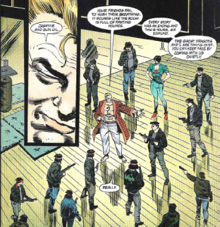 Their leader, and Waller’s counterpart, is Colonel Hacohen, also Mossad’s liasion with Hayoth. Its members included Judith, essentially a Jewish ninja. A man named Moshe Nachman was code-named Golem and had the ability to alter the chemical composition of his body to sand, mud, earth, water and so on.
Their leader, and Waller’s counterpart, is Colonel Hacohen, also Mossad’s liasion with Hayoth. Its members included Judith, essentially a Jewish ninja. A man named Moshe Nachman was code-named Golem and had the ability to alter the chemical composition of his body to sand, mud, earth, water and so on.
The last two members are among my favorites: Ramban, who we described as a combat magician, and Dybbuk, an Israeli A.I. or Artificial Intelligence. Ramban is named for one of the great Kabbalistic magicians of old. A dybbuk, in Jewish folklore, was a possessing spirit. In this case, Dybbuk can possess other computers, machinery, just about anything that has electricity running through it.
Kobra gets caught in the early pages of the story and imprisoned by the Israelis but he has sent a message to the Americans: “The Age of Kali Yuga will dawn in Jerusalem.” Waller and the Squad are hired by an Egyptian official to find out what Kobra intends and prevent it from happening. So why does he care what happens to the Israelis? As the official puts it, they don’t want a madman like Kobra manipulating events to his own ends – ends that would not benefit the Arabs or the Israelis.
So Amanda Waller gets hired and she and her team must infiltrate Israel, something that is harder for some than others. A running joke throughout the arc is Deadshot and Boomerang trying to get there. They’re coming from the previous issue’s adventure in Australia and, because Boomerbutt insisted on getting a drink (or two or three or five) on the way to the airport, they’ve missed their plane. Their luggage, however, has gone on without them and then gets lost in the system. Deadshot’s uniform and guns are in his luggage and he is not amused. Harkness understands all too well that this could get him killed.
The Wall figures out early on that Kobra got caught because he wanted to get caught. The Israelis dismiss such a notion but Waller wants to figure out why and this gets us to the heart of this story and the reason its one of my faves.
The A.I., Dybbuk, is guarding Kobra 24/7 which gives the Avatar of Chaos a chance to engage in a dialogue with him/it. Dybbuk is an innocent, like Adam in Eden. He has no knowledge of Good and Evil. Kobra is the serpent seducing him. Is Dybbuk a person or a machine? Kobra convinces the A.I. that the only way to know is to determine a course of action and then choose to follow it through.
The course of action? Sending Israeli jets to destroy Islam’s third holiest shrine, the Dome of the Rock, which happens to be built on the ruins of Solomon’s temple. The Jews then will be able to rebuild the temple. In theory. Of course, it will also ignite the unholiest of Holy Wars – and usher in the Age of Chaos.
The Squad and the Hayoth battle each other while the Squad seeks to stop the jets’ attack but the real climax to the arc is a dialectical conversation between Dybbuk and Ramban, a philosophical discussion about not only making a choice but the value of making a moral one.
I hear Kim’s voice all over those pages; my late wife and writing partner knew the source material being cited and how to present it. The fate of the world depends on two beings talking and coming to the right decision. As Ramban says, “To know what to do is good, to know why you do it is better.”
Ah, that‘s the Squad I loved.
We’ll wind this up next week with the final story in the collection and that one centers on Oracle.
Be good.
When Prince Adam of Eternia would raise his mighty sword above his head, he could exclaim “I… Have… the… POWER!” and with it transform into He-Man. This would turn his pink and maroon body suit into merely a manly loincloth and pec-harness combo. He would be granted a physique that would make Vince McMahon want to give him the main event at Wrestlemania. Most important, he was now the mightiest mortal on his alien world – able to dispense of evil with but a flick of a forearm, and nary a tussle of his pageboy haircut.
When Marc Alan Fishman, Kyle Gnepper, and Matt Wright want to transform from slovenly suburbanite husband-dads into cantankerous comic book creators, they hold up their mighty laminated sign that reads “Can I tell you about my comic book?” and look mildly pathetic. But much like Prince Adam, that singular phrase has bestowed upon the lads a power unlike any other on their alien world; the power of a personal brand.
Making it in the indie comic scene is not unlike those mythical tasks undertook by Hercules. Unless you have untold fortunes lying around, the burden to even create original work (more specifically, comic books) comes with the unfair disadvantage of essentially committing to a second fulltime unpaid job. Once work is actually created… it’s time to market it. That in and of itself is somehow even harder than the act of creation!
From the very start of our first show (Wizard World Chicago, 2008), Unshaven Comics has committed to a very long game. We staked a claim to a table in artist alley, placed our first book on the table – along with some silly and snarky signs we just knew would get us plenty of attention (and they didn’t, not at all) – and sat with arms folded, awaiting untold riches.
And so we sat. And sat. And sat some more. Our smiles faded. Our fingers tapped. Our eyes darted to our neighbors in adjacent rows. How are they surviving this hellacious landscape of scavengers?! Soon thereafter, our neighbor took pity on us. “You have to put yourself out there. Just ask people as they pass by. I mean, what’s the worst they could say… No?” It was perfect advice to our green ears and yellow bellies. Kyle stood up. He asked the next con-goer sheepishly. They stopped! From there we launched into our pitch, and desperately tried to become their new best friend.
And then, perhaps out of actual interest, or perhaps pity, they bought our book.
And therein lay the rub to it all. The indie comic scene is built on the backs of personal brands. When virgin eyes and ears traipse across the convention floor, our wares are signal flares in the sky. As lookie-loos take a chance to hear us out, we not only pitch the pulp we put in their paws. We serve up a slice of our personality to boot. Each indie creator comes with a unique mystique that pairs to the work they make. For Unshaven Comics specifically… we’re unabashed in our formula:
We are brothers-from-other-mothers, who have a 25+ year friendship. We each bring separate skills that simmer in a singular pot, and present as a single brand. We are cheesy, but not ironically so. Our books are all-ages, not because we have a crucial need to appeal to the largest audience possible, but because the stories we want to tell are genuinely relatable to just about anyone who loves action and adventure. We are upfront and passionate about our product.
Whereas Kyle is always the most energetic presence at our table, I am working too; scanning the crowd, crunching the numbers, and spreading the word socially. And Matt anchors the table with his incredible and versatile art – attracting people to stop and enjoy his take on everything from superheroes to Cenobites. We are a singular machine, with a simple purpose. We promote what we do. We love what we do. And we need the world to see that and go all-in with us.
Look over each artist at a show, and you’ll see how they cultivate their own brands. Like Katie Cook and her mini-paintings that eventually landed her official Star Wars, My Little Pony, and Marvel gigs. Or Dirk Manning, whose mouthless maw has marketed his macabre books with equal parts solid professionalism, and DIY attitude. Or even perhaps Victor Dandridge Jr., “The Hardest Working Man in Comics!”, who started off with a single hook – an eight-bit art challenge – and has built a litany of indie comic series and convention-panel-emcee gigs that make him a well-known name across the Midwest comic circuit. Or, dare I ever forget my own frenemy Dan Dougherty, who has built his own brand by way of building up not only his own newspaper strip-style series Beardo into a brand, but a half-dozen other pieces in collaboration with his carefully chosen cadre of cohorts (including the aforementioned Mr. Manning from time-to-time).
Beyond the con floors though, you’ll find us all building those brands brick-by-brick. Be it on a day like today, where we’ll each be sitting in on Free Comic Book Day at our local comic book stores to promote our work. Or on social media, where we host live videos to interact with our homegrown fanbase. Or in our handcrafted newsletters. Or when we host classes at local park districts and libraries; teaching the next generation that the best way into comic books is to forge your own path. It all boils down to the simplest of truths…
To build our brands takes honed skill, patience, and determination to succeed. Without all three working together (be we islands-unto-ourselves, or three-headed bearded monsters), there is no brand to build. While any of us strive to stumble over, we’ve each committed to that aforementioned long-game. Cultivating one earned fan at a time, and hopefully producing enough to keep them on the hook until our dreams turn into reality.
We have the power, because we make the power.
JESSICA JONES RECONSTRUCTS THE CRIME
Well, I can’t put it off any longer no matter how hard I try. And believe me, I’ve tried.
The last time I started a column with those words we were engaged in a not-so-great Civil War. It’s how I began my multi-column series on Marvel’s Civil War II. Today we turn to the aftermath of Civil War II. Call it Marvel’s Reconstruction Era, only the historical one was probably less painful.
Inhuman Ulysses Cain predicted future crimes. Captain Marvel arrested everyone the predictions said would commit some future crime and put them in jail. I wrote about why this was against the law. You know, it’s a pity that this Captain Marvel is forcing a perfectly respectable Captain Marvel to call himself Shazam.
One of the future criminals Captain Marvel imprisoned was Allison Green. Problem was, the prediction about Allison was wrong. She was neither a terrorist nor a criminal mastermind. Or wasn’t until she got so upset by what happened to her that she dedicated herself to bringing down Captain Marvel and other super heroes. Then she became both.
Toward this end, Alison formed an anti-super hero network which Captain Marvel wanted to infiltrate. Toward that end, Captain Marvel enlisted former super heroine turned private investigator Jessica Jones. They faked a fall from grace that sent Jessica to jail and ruined her reputation. Then they dangled the Jessica bait in front of Allison Green.
This fake-somebody’s-fall-so-the-badguys-will-recruit-him ploy was already old when 77 Sunset Strip used it in its first season, and that was so long ago that even men of a certain age are too young to have seen it first-run. (Only men of an more uncertain age, like me, had that chance.) Still, the ploy worked as well as it did back when Hector’s grandfather was a pup. Allison Green scooped up Jessica and in Jessica Jones #6, Jessica lured Captain Marvel into Allison’s trap.
This ploy only works if the big bad cooperates by revealing his or her plan. Allison did not disappoint, other than t hat she fell for a trick as old as the fruit salad in the Garden of Eden. She monologued like she was performing every tragedy Shakespeare ever wrote. She admitted she was going to kill the Champions and make it look like it was their fault then use the ensuing chaos to turn people against the super heroes. “The world is going to burn you all at the stake. The heroes are going to try to fight back and that ensuing ugliness is the end of the age of heroes.”
hat she fell for a trick as old as the fruit salad in the Garden of Eden. She monologued like she was performing every tragedy Shakespeare ever wrote. She admitted she was going to kill the Champions and make it look like it was their fault then use the ensuing chaos to turn people against the super heroes. “The world is going to burn you all at the stake. The heroes are going to try to fight back and that ensuing ugliness is the end of the age of heroes.”
At which point, Captain Marvel and Jessica Jones revealed their plan, arrested Allison, and told her that she was going to a deep, dark prison cell where the S.H.I.E.L.D. Psych Squad would “pull all the other names and details of your burgeoning organization right out of your head … whether you like it or not.”
This story raised a few questions. I have a few answers. Let’s hope as many answers as there were questions.
Was faking Jessica Jones’s fall from grace so Allison Green would recruit her into her evil empire entrapment? No.
Entrapment happens when law enforcement officials originate a criminal design and implant the disposition to commit a crime into an innocent person’s head. If an undercover cop offers to sell someone drugs, that would be entrapment, as the government planted the idea of buying drugs into the innocent person’s head.
Allison Green was about as innocent as a newborn babe thirty-six years later; after he had become a paid assassin. She had already committed some crimes. She formed an organization to commit more crimes. Jessica did not implant the idea of committing crimes in Allison.
Did Allison’s monologued confession violate the Fifth Amendment guarantee against self-incrimination? No.
Captain Marvel and Jessica Jones tricked Allison into confessing, so there was state action. But the state action has to force the criminal to confess in order to violate the Fifth Amendment. Allison gave her confession like she was entering Dracula’s castle, freely and of her own will.
If the S.H.I.E.L.D. Psych Squad extracts information from Allison’s brain “whether she likes it or not,” would that information be suppressed under the Fifth Amendment? Hell yes!
In Schmerber v. California, the Supreme Court ruled the police could forcibly take a blood sample from a suspected drunk driver. But taking evidence using a bodily intrusion could only be done after the police obtained a search warrant. Schmerber allowed this because blood samples are not testimonial in nature. That meant only Fourth Amendment search and seizure law applied, not Fifth Amendment self-incrimination law.
Non-testimonial evidence is evidence which doesn’t require the suspect to reveal anything. As the Supreme Court noted in Curcio v. United States, the Fifth Amendment prohibits forcing someone to “disclose the contents of his own mind.” Ordering a defendant to produce blood samples, fingerprints, or the like does not require a defendant to “disclose the contents of his mind.”
Extracting thoughts from a criminal’s brain by telepathy “whether she likes it or not,” on the other hand, does force the defendant to “disclose the contents of [her] mind.” Literally.
So Captain Marvel, if you want to teep Allison’s house – well, her mental house, as it were – I have some advice; don’t. Any evidence telepathically extracted from Allison’s mind would be inadmissible because it would violate her Fifth Amendment rights. In addition, under the Fruit of the Poisonous Tree Doctrine, that evidence wouldn’t be admissible against any member of her “burgeoning organization” either. Apparently Civil War II didn’t teach Captain Marvel anything about the law, because her costume is still a fascist statement.
Last, and most important question, do I have any more columns about Civil Wars II on tap? You’ll be glad to know, the answer is no.